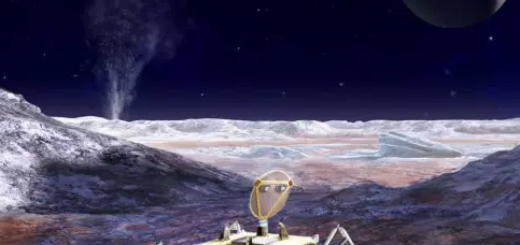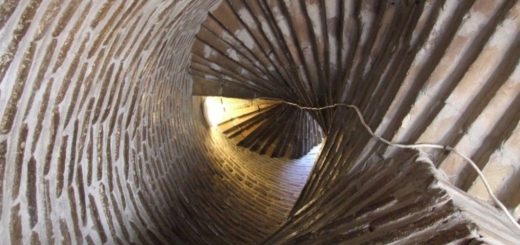Baltic Sea UFO Looks Like A Giant ‘Mushroom’ [VIDEO]

The unidentified circular object that has held the world in a viral grip for a year probably isn’t an alien spacecraft after all.
Over the past few days, divers have photographed the unusual anomaly on the seabed nearly 300 feet below the surface.
According to news released Friday by the OceanX treasure hunters who discovered the anomaly on June 19, 2011, “first they thought it was just stone or a rock cliff, but after further observations, the object appeared more as a huge mushroom, rising 10-13 feet from the seabed, with rounded sides and edges.
“The object had an egg-shaped hole leading into it from the top, as an opening. On top of the object they also found strange stone circle formations, almost looking like small fireplaces. The stones were covered in something resembling soot,” reports the OceanX website.
Baltic Sea UFO Turns Out Not To Be A UFO.
One of the OceanX divers, Stefan Hogeborn, a veteran of more than 6,000 dives in his 20-year career, is completely puzzled by what he saw.
“I have never seen anything like this. Normally stones don’t burn. I can’t explain what we saw, and I went down there to answer questions, but I came up with even more questions,” Hogeborn said.
The first pictures of the Baltic Sea object have been published by the Swedish newspaper Expressen, which reported the “images show that the circle consists of several blocks formed by ‘rolls’ or ‘mushrooms’ that are attached to each other, forming the circle.”
On another dive, a sledgehammer was used to obtain samples of the material. “Since we did not get any answers to the questions we asked ourselves, we have brought this to the experts who may be looking at the pieces we brought up,” said Hogeborn.
What does the Baltic Sea UFO look like close-up?
On-site researchers are still scratching their heads at the photographic evidence.
Treasure hunters Peter Lindberg and Dennis Asberg first discovered the jumbo jet-sized object — variously described as disc-shaped, circular and cylindrical — using side-scan sonar. When images and videos were released on the Internet, the story quickly went viral and speculation took off as to the identity of the object, which resembles the fictitious Millennium Falcon spacecraft from the “Star Wars” movies.
Everything from sonar glitches, a sunken Russian ship, naturally occurring stone outcroppings and, of course, alien spaceship have been debated over the past year.
On June 1, Lindberg and Asberg headed back to the location with deep-sea divers and remote-controlled cameras.
“We need to explore what we have found,” Lindberg, captain of the Ocean Explorer, said on the treasure hunters’ website. “Media has been speculating about everything from UFOs to Russian space ships, and the time has come to find out what the sonar image actually is.”
Isn’t it also about time that we all agree to refer to the anomaly as a USO, instead of UFO? USO, as in Unidentified Submerged Object. Because, in reality, nobody knows if this thing was ever in the air, flying, right?
“It was originally claimed to be a perfectly round disc, and of course, that’s one of the things that made it a mystery,” said Benjamin Radford, deputy editor of Skeptical Inquirer magazine. “If it’s a spaceship, as some have suggested, it must be almost entirely buried in the ocean floor,” Radford told The Huffington Post.
On June 11, UFO-Blogger.com posted this message from expedition co-leader Asberg: “Everything is top secret now … because of the risks … hope you all understand this is no game. But the truth will be reported shortly.”
Now that the team has almost certainly revealed that the mushroom-shaped anomaly is not from another planet, they’re still not exactly sure what it is.
“First we thought this was only stone, but this is something else,” said Lindberg on the OceanX website. “And since no volcanic activity has ever been reported in the Baltic Sea, the find becomes even stranger.
“As laymen, we can only speculate how this is made by nature, but this is the strangest thing I have ever experienced as a professional diver.”
Clarification: The headline of the initial version of this story gave the impression that the Baltic Sea anomaly is an actual mushroom. The story correctly quoted the on-site investigators who described the submerged object appearing like a mushroom. As this story progresses and analysis is conducted on samples of the undersea object, updates will be forthcoming.
Sonar image and artist rendering of the Baltic Sea USO.



 Creators of mankind
Creators of mankind Description of “Tall white aliens”
Description of “Tall white aliens” Where they came from?
Where they came from? About hostile civilizations
About hostile civilizations The war for the Earth
The war for the Earth “Tall white aliens” about eternal life
“Tall white aliens” about eternal life Video: “Nordic aliens”
Video: “Nordic aliens” Aliens
Aliens Alien encounters
Alien encounters The aliens base
The aliens base UFO
UFO Technology UFO
Technology UFO Underground civilization
Underground civilization Ancient alien artifacts
Ancient alien artifacts Military and UFO
Military and UFO Mysteries and hypotheses
Mysteries and hypotheses Scientific facts
Scientific facts


















